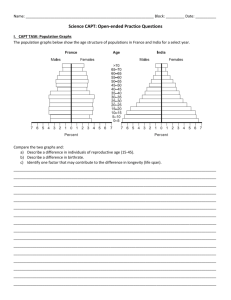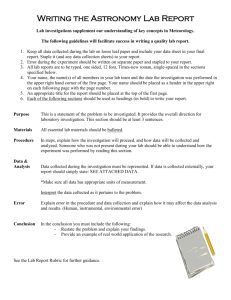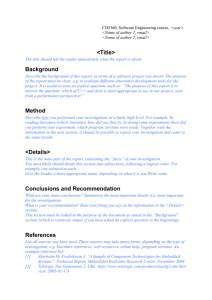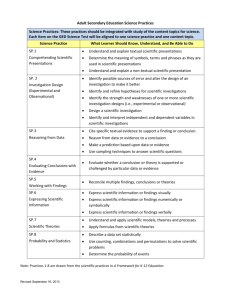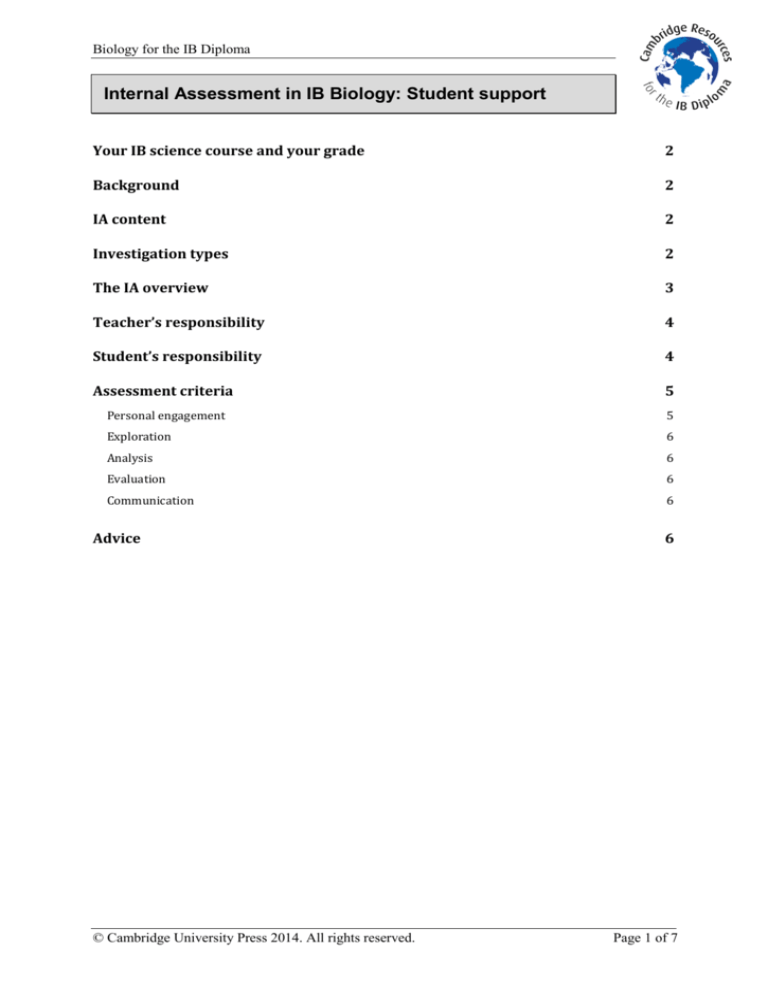
Biology for the IB Diploma
Internal Assessment in IB Biology: Student support
Your IB science course and your grade
2
Background
2
IA content
2
Investigation types
2
The IA overview
3
Teacher’s responsibility
4
Student’s responsibility
4
Assessment criteria
5
Personal engagement
5
Analysis
6
Exploration
Evaluation
Communication
Advice
© Cambridge University Press 2014. All rights reserved.
6
6
6
6
Page 1 of 7
Biology for the IB Diploma
YOUR IB SCIENCE COURSE AND YOUR GRADE
Your final IB grade for your group 4 science course is based on three examination papers and an
independent research project, called an ‘internal assessment’ or IA. The IA is a scientific
investigation that mirrors a real-world scientific study. You will define your own unique
research question and, with the guidance of your teacher, you will spend about ten hours of
class time working on your IA. Your investigation grade will contribute 20% to your total
science grade, so it is important that you do your best with this assignment.
BACKGROUND
Before your teacher introduces you to the internal assessment investigation, you will have
experienced a wide range of scientific theory and a wide range of related experimental work.
You will have learnt about safety and environmental issues in science, you will have worked
with a variety of scientific equipment, and you will have studied scientific methods, including
the handling of uncertainties, the construction of graphs and charts, and evaluating techniques
and methodologies. You will have learnt ICT skills, such as word-processing, data-logging and
data analysis using a spreadsheet as well as graphing using appropriate software. And, of
course, you will have learnt how to work on the internet and interact with computer
simulations as well as work with online databases.
IA CONTENT
The scientific content of your IA needs only to be in line with the course you are taking. This
means that if you are a Standard Level student, your IA need not go beyond the course content
of Standard Level. The skills and knowledge you require for the IA are well within the course
limits. This does not mean, however, that you cannot study topics or issues that take you beyond
the course content. Moreover, you can apply methods and techniques that go beyond the course
content. The opportunities are there for you to follow up on something that interests you.
INVESTIGATION TYPES
The IA criteria allow for and indeed encourage a wide range of investigation types.
Hands-on investigations – This includes many traditional experiments. Your teacher may
outline a number of standard investigations. The hands-on investigation type also
includes non-traditional research questions, where questions are open-ended and
exploratory. You may not know the answers to your research question but you will
investigate it.
© Cambridge University Press 2014. All rights reserved.
Page 2 of 7
Biology for the IB Diploma
Modelling and spreadsheet investigations – Here you may process primary or
secondary data and analyse it with a computer model. Spreadsheets and
graphing software can be used in all investigation types. In some cases, real data can be
compared to ideal data (based on theory) by using a spreadsheet or designing a
mathematical model.
Database investigations – Here you would access online databases for scientific
information. You would design a method to answer your research question using the
database, and perhaps graph or model the results. There is an increasing amount of
online scientific data, and your teacher can help you here.
Computer-simulation investigations – Investigations may involve computer simulations.
Here, you can obtain information or data that can be uniquely processed to discover
something that goes beyond the simulation’s routine. You can combine a hands-on
investigation with a computer model and compare the results.
Hybrid investigations – The types of investigations are not exclusive categories but rather
illustrate the wide range of acceptable investigation approaches. An investigation can
make use of any of these approaches.
THE IA OVERVIEW
Your investigation should have a purposeful research question and a scientific rationale for the
study. The IA models a real scientific study in style, form and content. The following is an
overview of the internal assessment.
Research question – You are to define your own unique research question. However, your
teacher can guide you into plausible and productive areas. You should have some topic
or idea about what to study before you talk to your teacher.
Guidance – Your teacher will be there to help with technical issues and to guide you
through the entire IA process. However, success is up to you. Your IA is your work, not
the teacher’s work. Your teacher will provide a structure and all the information you
need about the requirements and expectations.
Time allocation – You will be given ten hours of class time but you can do additional work
on your own.
Research – You are expected to do academic research on your topic. You need to set your
research question in a proper scientific content.
© Cambridge University Press 2014. All rights reserved.
Page 3 of 7
Biology for the IB Diploma
Report length – Your final report will be between 6 to 12 pages (excessive length
will be penalised). The maximum length includes footnotes or references as well
as data tables, graphs and charts, pictures and, of course, text.
Personal involvement – You are expected to ‘own’ your investigation, to demonstrate
some insight, initiative or personal interest in your investigation. This is what makes the
work fun.
Self-management – You are responsible for your work, including meeting deadlines.
Technology skills – You need to use ICT skills, including word-processing, spreadsheets,
graphing software and internet searches. You must also know how to reference all the
resources you use.
Presentation – The final report will be electronic, with word-processed text, mathematical
equations and electronically drawn graphs. The entire report should be a single
document, including appropriate referencing.
TEACHER’S RESPONSIBILITY
Your teacher will explain the IA requirements to you. Here is an outline of what to expect. Your
teacher will:
•
•
•
•
•
•
•
•
•
•
introduce the ideas and expectations of the IA
explain the scheduling and internal deadlines
outline the wide range of possible investigation types
provide an overview of available science resources and materials
outline a number of plausible investigation topics
provide you with several exemplar IA reports
provide you with one-to-one consultation to help you define a research question
approve or reject your research question before you start work
give you class time to perform your investigation
provide feedback on your first draft and give you time to make revisions.
STUDENT’S RESPONSIBILITY
You are responsible for having all the appropriate ICT skills, from word-processing and
spreadsheet analysis to using graphing software as well as knowing how to search the internet.
You must also know how to write a science report. Your teacher will help you here. Your biggest
responsibility is to guarantee the authenticity of your work. This means your work must be your
own work, and that any resources used (ideas, text, data, pictures) are appropriately referenced.
Plagiarism is a serious academic and moral crime, and any cheating will result in failure.
© Cambridge University Press 2014. All rights reserved.
Page 4 of 7
Biology for the IB Diploma
Your teacher will double-check the authenticity of your IA report, but you will sign an IB
form confirming that your work is indeed your own work. This is why references (giving
credit, referencing) are so important.
You are also responsible for your own time management. You are expected to meet the
deadlines your teacher assigns, as well as accepting the general advice that your teacher gives
you about your work.
Finally, you should be enthusiastic about your work. You should demonstrate initiative and
even ingenuity in the planning, design and production of your IA. You should be dedicated to
scientific problem solving. After all, your IA is your investigation.
ASSESSMENT CRITERIA
Your IA is a unique scientific investigation. No two students will do the same thing, although two
or more students may investigate the same general topic. The IA is to have a purposeful
research question and a scientific rationale for the study.
To help you understand the parameters of the IA you should look at the assessment criteria in
the IB Course Guide. These are not to be understood as a checklist but rather they represent the
skills and content that are expected in a good IA. Your teacher will mark your report when you
are finished so you do not have to worry about applying the criteria. You should, however, be
familiar with the five assessment criteria and what aspects you should address.
Each criterion begins with a general statement of what is assessed. Your teacher will provide
you with a detailed list of the assessment descriptors, the statements regarding what you are
expected to address in your lab report. The following comments about each criterion are to help
you appreciate what is being addressed in each. Because of the wide range of possible
investigations, not all descriptors may be applicable. If, for example, you work with a computer
simulation, there may be no safety issues (which are assessed under the Exploration criterion).
Personal engagement
This criterion addresses your involvement in the investigation. It is important that you are
interested in your topic such that you can demonstrate independent thinking, initiative or
creativity. You must also demonstrate a justification for your research question; perhaps there
is some personal significance, interest or curiosity here. Finally, you are to provide some
personal input and initiative in the designing, implementation or presentation of the
investigation. You are to ‘own’ your project, not just repeat something found in a science
journal. The expectations of personal engagement actually mean that you will have fun doing
the work.
© Cambridge University Press 2014. All rights reserved.
Page 5 of 7
Biology for the IB Diploma
Exploration
This criterion addresses your ability to select, develop and apply the scientific method to
a specific issue. You are to express a well-defined research question, set it in an appropriate
scientific context, and select relevant scientific equipment and methodologies to address your
question. You are to appreciate any factors that may influence the quality of your data. Finally,
you should appreciate any safety, environmental, and ethical considerations that may be
relevant.
Analysis
This criterion addresses your ability to obtain and process appropriate data in a way that
addresses your research question. This appreciation includes the treatment of errors and
uncertainties where relevant, the presentation of graphs or charts, and the precision and
accuracy of your data. Analysis also concerns the validity of your data in relation to answering
your research question.
Evaluation
This criterion addresses your methodology and your results as set within a genuine and
relevant scientific context. It focuses on how well your data supports the conclusion, including
the method and appreciating the strengths and weakness of your work. You are expected to
provide realistic and relevant suggestions for the improvement and extension of your
investigation.
Communication
This criterion addresses the overall quality of your report. It is a holistic appreciation of the
style and form of your presentation. You are expected to write in a clear and logical style that is
easy to follow. Your report needs to be relevant (no unnecessary explanations or tangential
issues) and concise (6 to 12 pages, and more than 12 pages will be penalised). The process and
the outcomes must be clearly stated. Appropriate scientific terminology and conventions must
be followed, and graphs, tables, images and charts must all be presented in a clear way.
ADVICE
The key to a successful IA investigation is in the initial planning. You will want to have a well-
focused research question, one that you and your teacher know you can research, experiment
on, analyse the results, then conclude and evaluate within the scheduled time. Albert Einstein’s
genius came from seeing complicated phenomena in basic ways. His famous energy and mass
equation is as simple as 1 + 1 = 2, and yet the equation E = mc2 is profound, insightful. In a
similar way, but perhaps not expecting the Nobel Prize in science, you are to come up an
interesting and well-defined scientific investigation. This is science at its best.
© Cambridge University Press 2014. All rights reserved.
Page 6 of 7
Biology for the IB Diploma
It is also important that when you do the research for your investigation you fully
understand and appreciate the existing scientific context of your study. Although your
final report should not read like a textbook, you should demonstrate a competent
understanding of the relevant scientific terminology, concepts and styles of presentation and
analysis.
Twenty percent of your total IB science grade is based on your IA. You will have time to study,
revise and receive your teacher’s help and advice, so the IA is a perfect opportunity to earn a
good grade.
Finally, you should have fun!
© Cambridge University Press 2014. All rights reserved.
Page 7 of 7


